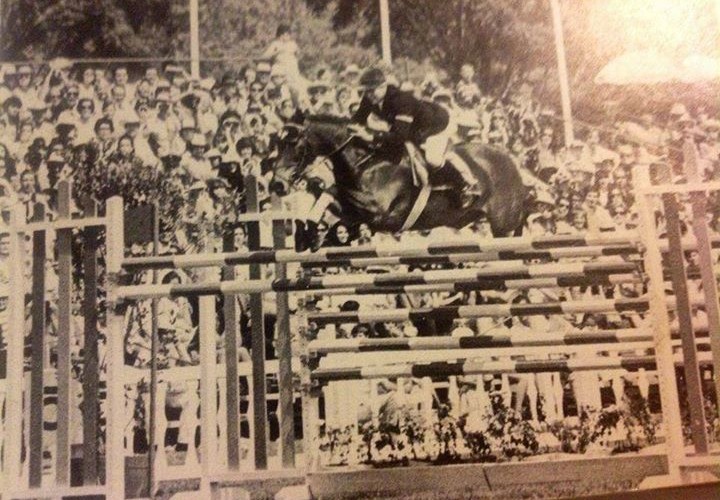Every little girl dreams of taking her very first pony to the Olympics, but for Marion Coakes Mould, it was no dream.
Nearly lost to the blurry black and white memories of another era, Stroller lives on for many as the go-to answer whenever anyone asks, “How tall does my horse need to be to move up the levels as a jumper?” At just 14.2 hands, Stroller was positively born to defy the odds.
Marion and Stroller met in 1960, when she was 13 and he was 10. She had been raised in a family rabid for jumping (her two older brothers were already members of the British junior show jumping team), but had to first prove her pluck as a 3-year-old on the family’s smaller ponies, and go up from there. Her first regular partner was a pony named Music, with whom she regularly won all the 13.2 and 14.2 junior pony classes. It was at the Wembley Finals, in fact, where she was showing and winning her classes with Music handily, that she and her father first came upon Stroller.
According to Marion’s memoir of her early days with Stroller, her father Ralph was anxious about seeing his daughter disappear behind giant solid fences, and only seeing her and the 13.1 Music when they reappeared safely on the other side of the fence. Perhaps she was ready for something just one hand taller. Ralph thought Stroller’s good breeding (Thoroughbred/Connemara cross) and small but lovely frame had the makings of a nice junior jumper pony for his daughter, but Marion had the last say. She couldn’t say no to Stroller.
“He hadn’t achieved anything outstanding but was such a lovely pony, plucky and handsome with the look of a real winner.”
Right away, the two were a ferociously brave match, and a force to be reckoned with around the British junior show circuit. When Marion turned 16 in 1963, her father thought it was high time to get his rising star daughter a bigger horse. Marion did have some good success with a “promising bay” named Summer Shandy and her older brother’s horse, Little Fellow, but Marion wouldn’t hear of turning over Stroller to another junior rider, and his scope and talent continued to produce wins. The matter of ending her ride on Stroller was dropped.
In the senior division, the pair didn’t slow down a bit; Marion and Stroller won the Queen Elizabeth II Cup at the Royal International Horse Show and three Nations Cup events in her second year in the senior division. They then tackled the Hickstead Derby, one of the most grueling, imposing, and legendary show jumping courses in the world. The mighty little pair won their Derby Trial round, and then placed second to Seamus Hayes in the Derby final. Great Britain — and soon the world — wouldn’t be able to dismiss the girl and her pony for much longer.
In 1965, Marion rode Stroller to a gold medal in the Ladies World Championship, and two years later came back and claimed her rightful spot atop the Hickstead Derby throne. She had the nation’s attention, and in 1968, represented Great Britain on the show jumping team and as an individual at the Olympics in Mexico City.
It was a bizarre year for all the equestrians at the Olympics, as many horses had a difficult time adjusting to the high altitude and moody climate of the Games’ location. Moreover, it was going to be a grueling challenge for the show jumpers: The initial round had 17 efforts in a vast arena to be covered in a blazing 96 seconds, and only four of those initial 87 rounds were within the time. The second course was intended to be more like a puissance, and the imposing central fence was 1.70 meters high and 2.20 meters wide. At 14.2, it’s probable that Stroller could have traversed under it as easily as over it.
Marion and Stroller clearing the puissance fence at the 1968 Olympics. Photo by Gonzalo Garcia Ceron, courtesy of Frank Waters.
But over it he went, and after the two grueling rounds and a jump-off that pitted the pair against the legendary Bill Streinkraus and Snowbound, Marion and Stroller took home the individual Silver Medal.
Marion Coakes, Bill Steinkraus, and David Broome at the 1968 Olympics medal ceremony. Courtesy of Show Jumping Nostalgia
Great Britain’s favorite little pair continued to clean up, and according to retired broadcaster and announcer Frank Waters, Marion became the first woman and Stroller the only pony (so far!) to ever win the Hamburg Derby, that in 1970 when Stroller was 20 years old.
Stroller got his well-deserved retirement the following year, which he enjoyed for a glorious 15 years before his death at the ripe old age of 36. Marion went on to win more awards with other full size horses, but it is with her childhood pony that she is forever enshrined in the history books of show jumping.
Go Stroller.
Many thanks to Frank Waters and his lovely Facebook Page for his help in this story – if you’d like to read more illustrious stories of the mid-century show jumping era, pick up Frank’s book, The Golden Age of Show Jumping.
Editor’s Note: This piece originally appeared on our sister site, HorseNation.com in March, 2015.




